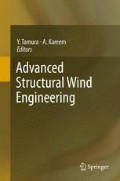Abstract
The time-dependent aerodynamic forces experienced by a structure immersed in the air flow relate to the wind properties directly. Understanding of the strong wind characteristics is very important for safe and serviceable design. This chapter focuses on strong winds and their characteristics. Wind climates that may bring strong wind, for instance monsoons, tropical cyclones, thunderstorms and so on, are briefly described together with the underlying hydrodynamics. Variation of wind speed with height above ground and turbulent structure inside the atmospheric boundary layer, including turbulence intensity and scale, gust factor, peak factor, decay factor of the coherence function, probability distribution function, power spectrum, and their variations with wind speed, are discussed in detail. In addition, Typhoon Maemi is referred as an example of strong wind event to exhibit the wind characteristics of strong winds.
Access this chapter
Tax calculation will be finalised at checkout
Purchases are for personal use only
References
AIJ-RLB-2004 (2004) Recommendations for loads on buildings. Architectural Institute of Japan, Japan (in Japanese)
Amano T, Fukushima H, Ohkuma T, Kawaguchi A, Goto S (1999) The observation of typhoon winds in Okinawa by Doppler sodar. J Wind Eng Ind Aerodyn 83:11–20
ASCE 7-02 (2002) Minimum design loads for buildings and other structures. American Society of Civil Engineers, Reston
Australian/New Zealand Standard (AS/NZS 1170.2) (2002) Structural design actions, Part 2: wind actions. Standards Australia & Standards, New Zealand
Cao S, Nishi A, Hirano K, Ozono S, Miyagi H, Kikugawa H, Matsuda Y, Wakasugi Y (2001) An actively controlled wind tunnel and its application to the reproduction of the Atmospheric Boundary Layer. Bound-Layer Meteorol 101(1):61–76
Cao S, Tamura T (2007) Effects of roughness blocks on atmospheric boundary layer flow over a two-dimensional low hill with/without sudden roughness change. J Wind Eng Ind Aerodyn 95:679–695
Cao S, Tamura Y, Kikuchi N, Saito M, Nakayama I, Matsuzaki Y (2009) Wind characteristics of a strong typhoon. J Wind Eng Ind Aerodyn 97:11–21. doi:10.1016/j.jweia.2008.10.002
Cook NJ (1985) The designer’s guide to wind loading of building structures Part 1. Butterworths, London
Counihan J (1975) Adiabatic atmospheric boundary layers—a review and analysis of data from the period 1880–1972. Atmos Environ 9:871–905
Deaves DM, Harris RI (1981) A mathematical model of the structure of strong winds. C.R.I.A. Report 76. Construction Industry Research and Information Association, London
Franklin JL, Black ML, Valde K (2000) Eye wall wind profiles in hurricanes determined by GPS drop wind sondes, extracted from Le et al. (2007)
Yaojun Ge, Xinyang Jin, and Shuyang Cao (2010) Comparison of APEC wind loading codification and revision of Chinese National Code. In: Proceedings of 6th workshop on regional harmonization of wind loading and wind environmental specifications in Asia-Pacific economies, Korea
Holmes JD (2001) Wind loading of structures. Spon Press
van der Hoven I (1957) Power spectrum of horizontal wind speed in the frequency range from 0.0007 to 900 cycles per hour. J Meteorol 14:160–164
Giang TG, Tamura Y, Cao S, Matsui M (2007) Wind-speed profiles in tropical cyclones. J Wind Eng 4(1):39–48
Letchford CW, Mans C, Chay MT (2002) Thunderstorms, their importance in wind engineering—a case for the next generation wind tunnel. J Wind Eng Ind Aerodyn 90:1415–1433
Letchford CW, Kwok K (2004) Simulation and flow measurement of atmospheric boundary layer flows. In: State-of-the-art wind tunnel modeling and data analysis techniques for infrastructure and civil engineering application, Croucher Advanced Study Institute, Hong Kong
Mason M, Letchford CW, James DL (2003) Pulsed jet simulation of a thunderstorm downburst. In: Proceedings of 11ICWE, Lubbock, 2249–2256
Oseguera RM, Bowles RL (1988) A simple analytic 3-dimensional downburst model based on boundary layer stagnation flow, NASA Technical Memorandum 100632. National Aeronautics and Space Administration, Washington
Powell MD, Vickery PJ, Reinhold TA (2003) Reduced drag coefficient for high wind speeds in tropical cyclones. Nature 422:279–283
Simiu E, Scanlan R (1986) Wind effects on structures, 2nd edn. Wiley, New York
Teunissen HW (1970) Characteristics of the mean and turbulence in the planetary boundary layer. UTIAS Review No. 32
Tsuchiya M, Kondo K, Sanada S (1999) Effects of micro-topography on design wind velocity—characteristics of wind velocity amplification around various topographies. Summaries of Technical Papers of Annual Meeting, Architectural Institute of Japan, 119–120
Tamura Y, Shimada K, Hibi K (1993) Wind response of a tower (Typhoon observation at the Nagasaki Huis Ten Bosch Domtoren). J Wind Eng Ind Aerodyn 50:309–318
WMO (2010) Guidelines for converting between various wind averaging periods in tropical cyclone conditions. World Meteorological Organization, WMO/TD-No.1555, Geneva
Xu YL, Chen J (2004) Characterizing non-stationary wind speed using empirical mode decomposition. J Struct Eng ASCE 130(6):912–920
Author information
Authors and Affiliations
Corresponding author
Editor information
Editors and Affiliations
Rights and permissions
Copyright information
© 2013 Springer Japan
About this chapter
Cite this chapter
Cao, S. (2013). Strong Winds and Their Characteristics. In: Tamura, Y., Kareem, A. (eds) Advanced Structural Wind Engineering. Springer, Tokyo. https://doi.org/10.1007/978-4-431-54337-4_1
Download citation
DOI: https://doi.org/10.1007/978-4-431-54337-4_1
Published:
Publisher Name: Springer, Tokyo
Print ISBN: 978-4-431-54336-7
Online ISBN: 978-4-431-54337-4
eBook Packages: EngineeringEngineering (R0)

